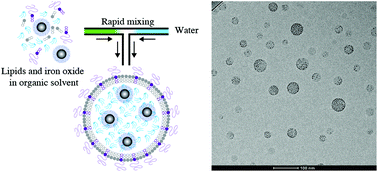Our official English website, www.x-mol.net, welcomes your
feedback! (Note: you will need to create a separate account there.)
Rapid synthesis of lipid nanoparticles containing hydrophobic inorganic nanoparticles
Nanoscale ( IF 5.8 ) Pub Date : 2017-08-15 00:00:00 , DOI: 10.1039/c7nr03272b Jayesh A. Kulkarni 1, 2, 3, 4 , Yuen Yi C. Tam 1, 2, 3, 4 , Sam Chen 1, 2, 3, 4 , Ying K. Tam 1, 2, 3, 4, 5 , Josh Zaifman 1, 2, 3, 4 , Pieter R. Cullis 1, 2, 3, 4 , Souvik Biswas 1, 2, 3, 4
Nanoscale ( IF 5.8 ) Pub Date : 2017-08-15 00:00:00 , DOI: 10.1039/c7nr03272b Jayesh A. Kulkarni 1, 2, 3, 4 , Yuen Yi C. Tam 1, 2, 3, 4 , Sam Chen 1, 2, 3, 4 , Ying K. Tam 1, 2, 3, 4, 5 , Josh Zaifman 1, 2, 3, 4 , Pieter R. Cullis 1, 2, 3, 4 , Souvik Biswas 1, 2, 3, 4
Affiliation

|
A straightforward “bottom-up” synthesis is described for efficient entrapment of inorganic hydrophobic nanoparticles (HNPs) consisting of iron oxide, gold, or quantum dots within the hydrophobic core of lipid nanoparticles (LNPs). These LNPs consist of hydrophobic “core” lipids such as triolein surrounded by a monolayer of amphipathic “surface” lipids, such as phosphatidylcholine and polyethylene-glycol-lipid. It is shown that rapid, controlled mixing of HNPs, core lipids and surface lipids in an organic solvent with an aqueous phase resulted in stable, monodisperse LNPs containing HNPs (LNP-HNP). This method allows 40-fold more hydrophobic iron oxide nanoparticles (IONPs) to be entrapped within an LNP than previous methods and can be readily extended to encapsulate other HNPs. The LNP-HNP diameter can be modulated over the range of 35–150 nm by varying the flow rate during particle synthesis or by varying the core-to-surface lipid ratio. LNP–IONPs can be generated using a variety of “core” lipids, including other triglycerides as well as cholesteryl-palmitate and tocopherol. Finally, it is shown that LNP–IONPs are accumulated in the liver, resulting in enhanced contrast for in vivo MRI. It is concluded that the bottom-up approach for encapsulating HNPs within LNPs has advantages of homogeneity, reproducibility and stability required for biomedical applications.
中文翻译:

含疏水性无机纳米粒子的脂质纳米粒子的快速合成
描述了一种直接的“自下而上”合成方法,该方法可有效地将脂质体纳米颗粒(LNPs)的疏水核中的氧化铁,金或量子点组成的无机疏水纳米颗粒(HNP)的捕获。这些LNP由疏水性“核心”脂质(如三油精)和两亲性“表面”脂质(如磷脂酰胆碱和聚乙二醇-脂质)单层包围。结果表明,HNP,核心脂质和表面脂质在有机溶剂中与水相的快速可控混合会导致含有HNP(LNP-HNP)的稳定,单分散的LNP。与以前的方法相比,该方法可使疏水性铁氧化物纳米颗粒(IONP)捕获的数量比以前的方法多40倍,并且可以轻松扩展以封装其他HNP。通过改变颗粒合成过程中的流速或改变核心与表面脂质的比例,可以在35–150 nm的范围内调节LNP-HNP的直径。LNP–IONPs可以使用多种“核心”脂质生成,包括其他甘油三酸酯以及胆固醇棕榈酸酯和生育酚。最后,结果表明,LNP–IONPs积累在肝脏中,导致增强的造影剂对比度。体内MRI。结论是,将HNP封装在LNP中的自下而上的方法具有生物医学应用所需的均质性,可再现性和稳定性的优点。
更新日期:2017-09-21
中文翻译:

含疏水性无机纳米粒子的脂质纳米粒子的快速合成
描述了一种直接的“自下而上”合成方法,该方法可有效地将脂质体纳米颗粒(LNPs)的疏水核中的氧化铁,金或量子点组成的无机疏水纳米颗粒(HNP)的捕获。这些LNP由疏水性“核心”脂质(如三油精)和两亲性“表面”脂质(如磷脂酰胆碱和聚乙二醇-脂质)单层包围。结果表明,HNP,核心脂质和表面脂质在有机溶剂中与水相的快速可控混合会导致含有HNP(LNP-HNP)的稳定,单分散的LNP。与以前的方法相比,该方法可使疏水性铁氧化物纳米颗粒(IONP)捕获的数量比以前的方法多40倍,并且可以轻松扩展以封装其他HNP。通过改变颗粒合成过程中的流速或改变核心与表面脂质的比例,可以在35–150 nm的范围内调节LNP-HNP的直径。LNP–IONPs可以使用多种“核心”脂质生成,包括其他甘油三酸酯以及胆固醇棕榈酸酯和生育酚。最后,结果表明,LNP–IONPs积累在肝脏中,导致增强的造影剂对比度。体内MRI。结论是,将HNP封装在LNP中的自下而上的方法具有生物医学应用所需的均质性,可再现性和稳定性的优点。











































 京公网安备 11010802027423号
京公网安备 11010802027423号